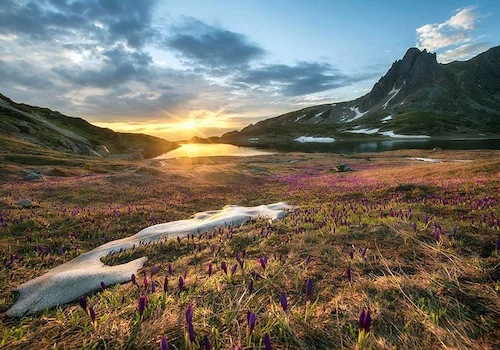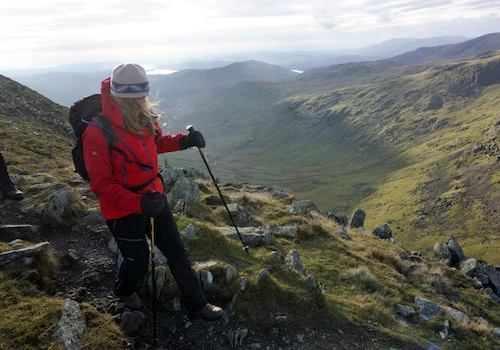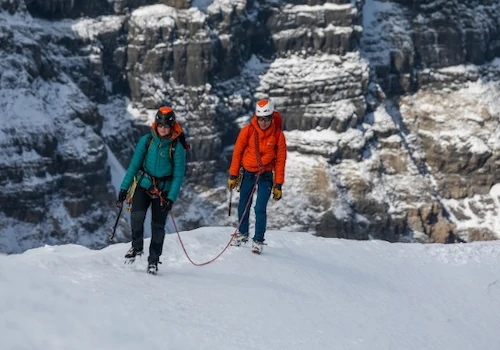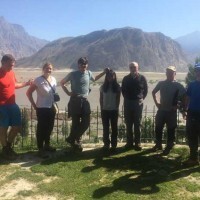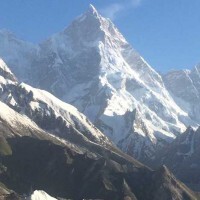
- Expeditions
By Region
By Month
By Grade
By Height
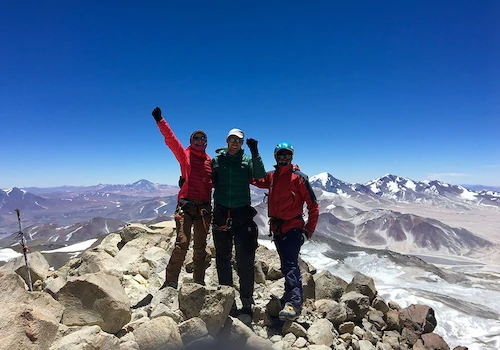
- Treks
- UK & Alpine
- Schools
- Hire
- News
- Shop
Trip Report - K2 - King of the Karakoram

We recently received a very detailed trip report from one of our clients on the K2 Base Camp Trek. Read on for a great description of the K2 Base Camp Trek.
Read full details of the Trek and book online with Early Booking Discounts of £100 for our 2017 dates
The Moment
“Don’t look left, don’t look left” I kept repeating like a mantra as I carefully negotiated the rubble on top of the Concordia glacier. Finally I could resist no longer as we reached an elegantly built cairn I turned and embraced the beauty and power that is K2. Whether it was the power of the mountain or the realization of a three and a half decade dream I hugged our guide Aman while tears flowed freely behind my glacier glasses. I was standing admiring my dream mountain. The King blessed me with his majesty. I was humbled and honoured.
The Beginning
I picked up a copy of “In the Throne Room of the Mountain Gods” by Galen Rowell in the old Mountain Equipment Co-op store in Vancouver. K2, majestically sitting at the head of the Godwin-Austen Glacier on the cover reached out and captured my heart. From that moment I knew I had to see my dream mountain in person.
Life has a way of causing dreams to wither a way. Rather we let them wither away. I promised myself that if I reached 65 and was in good health I would follow my dream. Life takes many turns to which we can choose to let them define and control us or we can accept and embrace these life events and move on. One such event occurred in November 2010 when we learned my wife, Iona, had cancer. Nearly three years later on August 26 the cancer won the battle. I was fortunate to have been her caregiver for the final two years. We talked about many things including carrying on with life, following dreams and making sure our son with his disabilities was cared for. Iona and I had travelled extensively but not to the high, wild, remote places. She was a 5-star hotel girl who loved the symphony, art, museums, history and culture. I learned so much from her and she helped me grow into what I believe is a better person. But my passion for the remote locales, especially the mountains simmered and persisted.
After her death I decided to follow my dreams of visiting those wild and remote places. And thus began in earnest my quest to trek into K2 – my dream mountain.
Another of life’s surprises occurred while trekking in South America. Through the magic of email I reconnected with another amazing lady, Cynthia. We had first met 20 years ago when the first guide dog she and her daughter raised graduated and became my son Angus’s first guide dog. Although we had stayed in touch it had been 6 or 7 years since we had seen one another. After returning from South America and Cynthia from one of her numerous business trips I drove down to the Seattle area for a catch up visit. For the second time I became smitten and blessed with the love of an amazing lady. Cynthia encouraged me to continue following my travel dreams. She joins me when she can, including a most wondrous 800 kilometre walk across Spain on the Camino de Santiago in 2014, and the West Highland Way in Scotland just before I flew to Pakistan.
The planning for the trek into K2 had continued but since the tragic events on Nanga Parbat in 2013 trekking in Pakistan was more difficult. Most companies had stopped offering treks to the Northeastern area of the country. I finally found a British company, Adventure Peaks, that was still offering a trek into K2 base camp. Interest in the trek was not overwhelming but by April of 2015 the trip was confirmed. It was in my 65th year and my health was good, my dream was becoming reality. With the final bureaucratic details tidied up I was on my way.
The Team
Our group comprised six ardent Trekkers and adventurers from far and wide plus a leader from Adventure Peaks, they were:
David from Glasgow is our most experienced adventurer. He frequently entertained us with stories of his adventures or experiences from his electric utility days. His hearty laugh could be heard throughout the camps. He also became our unofficial spokesperson due to the respect he garnered and his take charge personality.
Gary, was our resident film and television aficionado. Born in South Africa he now lives in London. His amazing recall and reprise of seminal movie and television moments kept everyone entertained. A big, tall, physically imposing person he is as gentle a person as exists. Any threat of confrontation will cause him to retreat to his “happy place”.
John D., an accomplished captain of very large tanker ships hails from Ireland. His rye Irish wit broke us up on many occasions. A wise and quiet gentleman he too has some notable trekking achievements. His dogged determination serves him well.
Lilly from New York is everything New Yorkers are thought not to be. Quite, modest, self-effacing and with a smile that could light up a stadium. She is petite in every way but has a heart of a lioness and endless determination as she bounds up and down the hills and dales of the glaciers and mountains. She could also engage Gary in the entertainment industry events.
Mary from London is another intrepid traveller with a penchant for the more challenging strolls. Filled with an affection for people, especially children, she was often found getting photographs and hugs. Just as much though she loved to be in the photograph. A determined walker she never allowed anything to get in her way. Not even a broken foot for the final three days of the trek. She was never shy about making definitive proclamations, some of which had us in stitches.
Lee, our team leader, is from the Lakes District in England. Highly experienced, thoughtful, intelligent he exuded confidence and leadership by an inclusive approach. He also has an amazing ability to forge relationships with the local people, and especially with our guides and our support staff. Lee was as comfortable, sharing a meal with locals, showing the porters how to properly set up or take down the new tents as he was dealing with the myriad officials. An extremely adept and knowledgeable trekker, explorer and mountaineer he was the ideal complement to us and our guides.
This small group quickly came together progressing through the ‘forming, storming, norming and performing’ team evolution in a couple days. I have never been with a more cohesive group in this type of situation. There were no egos trying to dominate or attention seekers. Everyone was focussed on completing the trek safely and healthy and enjoying every moment to the fullest.
But the team was not just us. From the outset it quickly grew to include everyone. I attribute this to Lee’s approach and leadership and to all of us respecting our support group as equals. Any success we might have would only occur if we were all worked together. By the end everyone was pitching in everywhere.
I cannot provide a comment on all of the local people. But these are my observations of the leadership group:
Najmul is the Managing Director of the Adventure Peaks’ agent in Pakistan, a long established trekking firm started by his father some 30 years ago. He exudes business acumen that is complemented by a warm and brilliant smile. His focus on customer service and customer satisfaction is beyond reproach. Affable and honest he never shied away from any question. He is helping his father rebuild the business that was hard hit by the loss of tourism activity caused by years of terrorism throughout the world, the 2008 economic crash and the tragic events in 2013. His real passion is the IT industry. He wants to put his degree to use by starting his own IT company. On this trip he was determined to make it the best it could be, but, he let everyone do their job. The sign of a good leader.
Aman from the village of Hunza was our guide. Many of the elite Pakistani climbers and porters are from the Hunza area. With some 25 years of guiding experience and over 30 trips into the K2/Concordia area he knew the ropes. Aman always carried himself with a calm, confident manner. He seemed unflappable and always in control. His knowledge and wisdom were a constant reassurance. Aman’s warmth, smile and laughter would emerge in those moments when the risks were absent.
Yasser our assistant guide and Business Manager at Adventure Peaks’ agent in Pakistan would be a heart throb anywhere. Handsome and blessed with a million dollar smile and heart to match. Like the Shadow he was everywhere. He seemed to have extra sensory perception when someone needed assistance. One minute he would be knee deep, barefoot in the middle of a rain induced torrent helping everyone safely across, the next serving green tea and treats and then appearing from nowhere to assist with a bag or tent zip. Ever shy he would instantly be surrounded by children in the villages whom he would entertain for hours.
Zaheer from the village of Hushe was our chef. Sitting like Buddha in front of his meagre cooking facilities he and his assistants continually supplied us with copious quantities of nutritious and very tasty meals that fuelled our bodies. A warm and compassionate man he always had a ready smile, encouraging word and hug.
Mustafa was the Head Porter. A serious looking man who at first seemed somewhat distant he soon warmed to the friendliness from Lee and the team. Amazingly strong and agile he would glide up hills that had most of us sucking wind.
Every group or activity is bound to have someone or something that is not as good as it should be. For ours it was the Liaison Officer (the LO). The LO is required for any individual or group that is planning to cross the Gondogoro La (pass). The LO role and responsibility actually seemed to be little more than a way for the government to extract money from foreigners. I do not want to paint all LOs with the same brush as others we met from different groups seemed competent and useful. We were ‘graced’ with a lazy, arrogant, self-indulgent lout. He was a great risk to our chances of being the first group in nearly four years to cross the Gondogoro La. He was also a great embarrassment to the entire Pakistani group. While all of them could walk circles around us the LO in spite of having most of his weight carried by a porter and being less than half our age continually lagged far behind. Probably the best description was from David who quipped “With a great deal of hard work he may achieve mediocrity.”
The Journey
Landing at Skardu’s notoriously difficult to reach airport on our first attempt seemed to be a good omen. As we stepped off the plane the mountains surrounding us were stunning. But nothing compared to what awaited us.
Two days in Skardu were more than enough with its stinky, smoke belching vehicles beeping their way along the people and cattle littered main street. It was interesting but we had another place to be. What struck us the most was how friendly everyone was. This country which all too often is poorly portrayed in Western media as unfriendly and teeming with Western hating terrorists is the exact opposite. Everyone was friendly, welcoming and proud. Certainly the Baltistan region proved to be so over and over. We walked freely around Skardu at all hours and never felt ill at ease. I am not aware of an unkind word or gesture toward anyone.
On July 8 the trek began in earnest with a 7-8 hour ‘jeep’ ride to the small village of Askole. Although only about 150 km the Toyota Landcruisers were rarely above second gear and never into fourth. Parts of the route are ever changing as the creeks which can explode in size in a matter of a few hours bring down debris, especially rocks and boulders that have to be navigated around. Roads and bridges can suddenly disappear or be totally stranded.
The route initially follows the Indus River before crossing some low foothills that separate the Shigar Valley and Braldu River from the Indus until they join several kilometres downstream. The route after the village of Shigar becomes more and more breathtaking in every sense of the word. Crossing sometimes raging streams or clinging to the side of canyon walls with the swollen, dirty Braldu moving massive boulders as it thunders towards the Indus can be exhilarating or terribly intimidating. Our Pakistani drivers were maestros in conducting the Toyotas to their final destination of Askole. All the while the mountain landscape was getting more spectacular.
After camp setup and other details we visited the tiny village including a museum that comprised one of the first homes. The area has been inhabited for over 400 years. The original inhabitants crossing one of the high mountain passes to escape aggressors and find a peaceful homeland.
The LO, a Lieutenant flight engineer with the Pakistani Airforce, also started to exert his authority after having his butt chewed out by a senior official. Apparently the group was to stay together at all times. Who knew. But he wasn’t helping to solve the issues.
Meanwhile the rest did our acclimatization hike two days early. A 500 metre jaunt up and down a nearby mountain gave us a good workout. Around 1300 hours John and Najmul arrived in camp. There was an immediate lifting of spirits as the uncertainty was gone but more importantly a sense of normalcy and completeness was restored. Even after just a few days we were a team of six.
July 11 we were on the trail around 0600 hours. The weather had changed as we spent most of the day walking to Paiju Camp in intermittent showers and rain that carried over from the previous evening.
The trail gradually became more rugged including high traverses above the Braldu and tippy toeing along the edge of the river that was a continuous ribbon of power. Another constant from the river was the rumble of large boulders being carried downstream by the power of the water. It often sounded like thunder.
Paiju Camp brought us to within an hours walk of the toe of the Baltaro glacier. The last night for a while that we would not be sleeping on or beside a glacier.
The weather began to improve and we were being treated to more and more spectacular mountains including names that litter the annals of Karakoram mountaineering history, such as Paiju Peak, Atwa, the Trango and Cathedral groups, Uli Biaho Tower, Liligo Peak and more.
July 12 the Baltaro glacier welcomed us this morning. Our progress slowed as the need to watch every step became not only routine but a requirement. For those of us with a penchant for wandering down a trail searching for hidden treasures like birds, animals, flowers, etc the requirement to watch every step caused a major and rapid change of technique.
We quickly came to realize what a gem we had in our lead guide Aman. A quiet but amazingly competent man he proved virtually unflappable. Having guided for nearly 25 years including over 30 times into this superb setting. He continually found the safe route across the glacier with rarely a misdirection.
Traversing a glacier is like following a male dog. Seemingly wandering aimlessly the reality is there is an end destination in mind. How one gets there is never certain. Glacier travel rarely follows precisely the same route from one day to the next. Routes may change during a day as glacial meltwater swells with rain or sunshine, the risk of rockfall increases with the temperature.
This is one of the most dynamic and interesting places on the planet. One can observe almost daily the Earth going through changes that form and create the landscape that in most other places occurred millennia in the past – landslides, avalanches, glacial lakes forming and disappearing, rivers carving away the land, cornices caving, rocks and soil being ground into powder, lichens, moss and plants doing their utmost to get for the most part a tentative and temporary foothold only to succumb to the power of change. But with time they become more permanent and begin the ecological succession that one day will see a meadow or a forest where today there seems to be only rock and ice. A time long ago it is believed that the Bens and Munros of Scotland reached lofty height that may have exceed the mighty Himalaya and Karakoram.
More grand mountains revealed themselves: the grand Trango Tower. A spectacularly elegant and beautiful rock spire and the scene of one of the most legendary mountain climbing achievements when Doug Scott of Britain successfully reached the summit.
Each day we were steadily and safely gaining altitude. Our bodies were adapting to the declining levels of oxygen. Even so most of were finding hills that we could literally run up at lower elevations left us breathing deeply.
This day in which the weather started to turn for the better found us camping at Khoburtse once again being in awe of the spectacular views.
July 13 was a quasi rest day was we only walked for about 2.5 hours and gained a 100 metres of elevation. Most days involved 6-8 hours and 3-400 metres of elevation gain. To safely acclimate the daily elevation gain should be no more than about 400 metres. That said the total elevation gain and loss far exceeded this amount as we scrambled up and down the hills and valleys of the glacier but the net amount is the critical factor to minimize the risk of Acute Mountain Sickness.
We finished the day at Udurkas Camp having glorious views of Gasherbrum IV, Broad Peak and glimpses of Gasherbrum I, Mitre Peak and more. The Nameless Tower was dominant from camp.
As we reached camp we observed a large, beautiful cornice high above our camp. I thought that having a large ridge between camp and the base of the mountain was a good thing. And it was as about 2:30 AM many of were awakened by a thunderous rumble. The next morning at least half the cornice was gone. This was the first of what would become a regular event of avalanches and landslides letting go at all times of the day and night. Those at night, however, seemed more ominous as you lay in your tent with nothing to do but listen and hope it stops or misses.
July 14 we trudged up the Baltoro glacier and on to Concordia, another legendary site sitting at the foot of Gasherbrum IV. It is the confluence of the Baltoro, Concordia and Godwin-Austen glaciers. Here, facing Gasherbrum IV a right turn leads to the basecamp for Gasherbrum I and Gasherbrum II. A left turn takes you past Broad Peak basecamp to K2 basecamp. This is the greatest concentration of 8000 metre peaks on the planet. It truly is the Throne Room of the Mountain Gods.
On the way we had also passed Masherbrum which is also called the Queen of the Karakoram and was initially believed to be the highest of the Karakoram peaks. It was designated K1 by Thomas Montgomerie of the Great Trigonometric Survey of British India when he first saw the mountain as he approached it from Hushe. Hushe is located one valley South and was our final trekking destination. We had also passed the Younghusband glacier on our left with the Mustagh Tower. This is a route that will take a trekker to the North side of K2.
We spent the rest of the day marvelling at the spectacular scenery and depleting our retinue of superlatives. K2 meanwhile kept a steady vigil at the head of the Godwin-Austen glacier. It seemed we were continually checking to confirm this natural miracle was still there every few minutes.
The Concordia glacier is one of the coldest places to sleep. Several hundred feet of ice, an elevation of 4500 metres and an almost constant wind all contribute.
K2 basecamp at 550 metres higher is substantially colder which would cause our support team to be exceptionally uncomfortable. Our porters like most porters or Sherpas around the world rely on the seasonal work provided by adventure trekkers or mountaineering expeditions for the income to support them and their families for the entire year. The tourism industry in Pakistan has been hard hit over the past 15 years beginning with 9/11 and then the 2008 financial crisis and the killing of climbers and porters on Nanga Parbat by the Taliban in 2013. Western media continues to focus on the negative fringe groups casting widespread misperceptions about Pakistan and Pakistani people. There is no question that there are Taliban and other unsavoury factions in Pakistan, but they are in the vast minority. No one wants them gone more than most of the citizens of Pakistan.
Our support team starting with Najmul, Aman, Yasser and including the cooks, porters, horse wranglers and more were fabulous. Kind, happy, courteous, helpful and more. Our team, starting with Lee was exemplary in treating them respectfully. Never did anyone treat them as anything less than an integral part of the team. We all succeeded or we didn’t. However, we also heard many comments that many trekking and climbing parties do not.
We reached a compromise on K2 basecamp. Broad Peak basecamp is approximately halfway to K2, is some 275 metres lower and substantially warmer. We would walk into K2 but sleep at Broad Peak basecamp.
July 15 was our second brilliant day and K2 continued to display its beauty and power. A roughly 18 kilometre walk brought within touching distance of this hallowed mountain. Our first stop however was to visit the Gilkey Memorial. Perched on a promenade above the glacier and with a grand view of the glacier, basecamp and K2 and Broad Peak it is an admiral way to honour the unfortunate people who lost their lives climbing these mountains.
The memorial is named after Art Gilkey a member of the 1953 U.S. Expedition who died on K2 in a tragic and heroic event where Peter Schoening almost single handedly saved several members of the climbing team. Gilkey was not so fortunate. Everyone on our team seemed to know of someone who had died on K2.
Aman in his special way found a small stone for each of us that had a similar shape as K2.
Next we continued to K2 basecamp. There were two expeditions attempting K2. We were surprised to meet three of our porters but it seems pilfering the good ones is common practice. Since expeditions pay better than treks they quickly attract good porters, especially those who are experienced at altitude. The very best get to climb with the foreigners which these fellows would. We wished them well as they had become part of our team.
We also met one of the Pakistani climbers who successfully climbed K2 in 2014. A very shy and unassuming gentleman. This was a celebratory climb as it was 60 years after the Duke of Arbruzzi’s Italian expedition that was the first successful attempt on K2. It was the first time a Pakistani expedition had successfully climbed K2. All previous successful ascents were done as porters.
K2 rises over 3.5 kilometres (over 2.1 miles) above the glacier. The best example of the visual impact I can offer is Mt. Rainer in Washington State. K2 is an enormous mass of rock and snow, much steeper than Rainer and for some reason more powerful and ominous. One in four of those who summit K2 do not, unfortunately, live to celebrate their success. That is one of the very poignant and sobering reminders when at the Gilkey Memorial. Some may point out that the comparable statistic at Mt. Everest is 1:9 but K2 does not suffer the same indignity of ‘want to be mountaineers’ being drug and carried up the mountain by Sherpas. Only elite mountaineers, porters and Sherpas attempt K2. So the death rate is even more sobering.
We returned to Broad Peak basecamp for dinner and a well deserved rest. Once again we were surprised when Najmul introduced us to the youngest Pakistani climber to summit K2. A tall, slim, handsome young man of 24. One of my first thoughts was were he from Europe or the U.S. he would be an instant celebrity. He was working with one of the expeditions on Broad Peak as a high altitude porter.
There is another issue at play in the climbing world that creates challenges for Pakistani porters, especially the high altitude fellows. The climbing seasons in the Himalaya and Karakoram are slightly different. The Nepalese Sherpas are probably the best in the world at supporting climbers. They also charge less than than similarly qualified Pakistani porters. This not only takes jobs now but makes it more difficult to gain the expertise and experience for the future.
July 16 dawned clear but over Broad Peak a sun dog was evident. This is frequently a precursor to a change in the weather. Something that was beginning to weigh on our mind as today was decision day for the balance of the trek.
In addition to getting to K2 basecamp and at least climbing on the lowest elevation of the great mountain we had an opportunity to cross over one of the highest passes in the world. At 5600+ metres the Gondogoro La represented a challenge on several fronts. The pass has not been crossed since 2011 and last year was closed when two high porters and a trekker died trying to cross without fixed ropes.
This year there was another factor. Unseasonably deep snow. Normally snows stops falling around the end of March but this year snow was still falling in July. We had seen it at the higher elevations while we got rain. For us to get over we needed favourable weather for another two days that would allow us to get up to Ali Camp at 5000 metres, and then for a midnight start to climb the final 600+ metres on firm snow. We also need fixed ropes that would assist us to ascend and descend safely. The route is heavily crevassed thus the ropes would be a guide and a safety factor. We – the guides, cooks, porters, clients and LO had to be physically and mentally competent and capable. The consensus was this chain had one seriously weak link – the LO. The guides, cooks and porters were ready and able, Lee our leader was like a thoroughbred, we six had proven capable to take on the challenge. The LO who had stayed at Concordia to rest, but had missed out on the acclimatization benefit of going into K2 had to go over the pass. We could not go without him.
As we returned to Concordia we were treated to an utterly amazing display of rings and rainbows. One of the rings was a perfect circle that emanated from the sun. Two other rings intersected with it at about 180 degrees from the sun forming a brilliant but simple type of cross. Rainbows were everywhere. It was spectacular and almost ominous. Aman suggested it was a
bad omen but for what he was uncertain. A change in the weather seemed on the way but did not appear imminent.
As we walked back to Concordia we were anxious to learn whether the questionably named Rescue Team had been successful in traversing the route in reverse from Hushe and establishing the fixed ropes. Formerly there was a Rescue Team, funded by the government. Today the Rescue Team was hired by Najmul’s father Mabarak but was part of the trek cost.
The waiting carried on into the evening. The supplies had been been split up – that we would take with us and that that would be taken back to Askole. Finally around 1900 hours Lee, Najmul, Aman and the LO came into the eating tent. They gave us the most current information and left us to make the decision.
The facts: The Rescue Team had not arrived and therefore we likely had no fixed ropes or safe route; there was a reported 4-7 feet of snow; the weather was changing with rain (and probably snow at higher elevations) predicted to start the following afternoon; and there were two high altitude porters in camp we could hire who were willing to try to help us.
The team had a brief, quite intense discussion and quickly reached the consensus decision that the risks were too great to attempt the Gondogoro La. We were all disappointed but for none of us was it the first time we had to abandon a goal for safety reasons. The relief on the LO’s face was palpable.
We quickly refocused on setting the new plan to return to Askole but in little more than half the time we took to come in.
July 17-20 involved three long days and one relatively easy day. The forecast rain arrived as predicted on the afternoon of the 17th. The rocks were slippery, in places the sand/gravel that provided traction on the ice had been washed away, the route had to be changed in places as the glacier’s creeks were swelling in the afternoon. One large lake we saw on the way in was virtually gone as the ice dam had broken, more rocks and debris was slipping off the hillsides. Our focus had to be even more attuned to what was happening. Through it all Aman retained his cool, calm demeanour giving everyone confidence. Each day brought new adventures and challenges. On the last two days the major risk was crossing swollen streams that were rising noticeably in the minutes it took the group to find a route and cross. Rocks and boulders were moving, banks were caving in. The landscape was once again being transformed before our very eyes. Everyone rallied and supported to ensure everyone crossed safely. Even with his calm demeanour the tension was obvious on Aman’s face.
We reached Askole, the end of the trekking about mid-day. Emotions were mixed – accomplishment, relief, sadness, pride and more. Late in the afternoon a deep and growing roar permeated the camp and the valley. We witnessed a massive landslide that thankfully followed a deeply incised stream bed directly across from our camp. Boulders the size of small and medium sized automobiles flowed down the channel mixed with liquified soil and water. A glacial lake high above must have released carrying tons and tons of material down the mountain side. It was many times larger than anything we had to cross but was another stark reminder of how dynamic and powerful this landscape is.
We said our final good bye to our porters. But before doing so each client chose to sponsor one of the porter’s children to get their education. Najmul’s company will coordinate the effort but we all embrace the idea that learning, opening minds, creating ideas is the best hope to make the world a more compassionate and safe place for everyone. The poignancy was brought to me this past weekend when I saw the following bumper sticker – “A closed mind is a great thing to lose.”
Around dinner time we learned that Pakistan’s most famous female climber, the first to climb Everest, had arrived in Askole with a broken arm. She had been climbing of K2 when a large piece of ice broken off or shifted breaking her arm. Later there was worse news as we heard seven people climbing on Broad Peak had been killed by an avalanche near camp 1. By morning it had been clarified to one Pakistani porter killed and a Chinese,and Japanese climber critically injured.
Although not carrying nearly the degree of risk as climbing I believe these events give us a momentary causes to pause and reflect. We do our best to understand and minimize the risk of our adventurous lifestyle but we will continue to explore the wild and wonderful places. The alternative of sitting in front of a television for hours is too horrible to contemplate.
July 21 we were on the road by 0530 hours for the drive to Skardu. We had heard about new wash outs and landslides. The drive back took longer as the road condition was worse. It also seemed longer and bumpier because there was nothing as special as K2 waiting for us.
Although an almost real shower and a bed sounded pretty enticing. Our shower in Skardu consisted of a bucket and a pail. Simple but effective.
July 22 our run of good luck continued as we were the first people to fly out of Skardu since July 19. In the late afternoon we visited the King Faisal Mosque in Islamabad, the largest mosque in Pakistan. Later we wandered the bazaar in Rawalpindi. These are different ways to get closer to the real people. At both but especially the mosque we became the novelty. Many of the visitors to the mosque were from the remote areas of Pakistan. We were likely the first or among the first Caucasian people they had seen in person. We were treated very kindly and almost became celebrities. Photographs were the norm. I suggest we all did our various nations proud.
July 23 following David’s suggestion we made a five + hour bus ride to Lahore to visit the old Fort and to observe the ceremony for closing the Wahga Gate between Pakistan and India.
Lahore is the second largest city in Pakistan with some 10 million residents. Karachi is the largest with roughly twice the number of inhabitants. We visited the Lahore fort getting a brief glimpse of some of the colourful history including the Mongols, the Sikh and other Indian influence that predates the partition in 1947, the British and more recent. It was fascinating.
Our final activity in Pakistan was the daily ceremony leading to the official daily closing of the border crossing at Wahga. Both countries have colourfully uniformed representatives. Thousands, mostly residents, turn out every day to witness and participate. Viewing stands and pre-ceremony activities abound. The national pride on both sides is palpable but displayed with enthusiasm, respect and decorum. India has more participants but the Pakistanis are the loudest and most boisterous. Taking upwards of an hour once the formal ceremony commenced the audience is treated to high – no very high stepping and enthusiastic displays of marching and fist pumping. For anyone interested check out U Tube.
The Epilogue
Travel, whether nationally but especially internationally is a blessing and one of the greatest educators possible. Many of us in the Western countries are currently blessed with the ways and means to visit and explore amazing places and meet and engage outstanding people. We owe it to ourselves, our families and countries to visit the countries our governments think we should not. We need to go with an open mind and an open heart. To be the good will ambassadors the world needs. To pull back the shrouds of ignorance.
This trip may be my most special of all so far and maybe forever. I was able to realize a dream that had its embryonic beginning over 35 years ago. It may seem trite to some to become emotional over a mountain. I do not need to explain. In fact I am not sure I can. K2 has a connection to my heart and soul that I do not fully understand. I accept and embrace it unreservedly.
To have shared the moment and experience with those I did – all total strangers a little more than a week earlier, is also special. Many who factored so importantly in our success are the wonderfully warm, happy, friendly, kind people of the Baltistan region of Pakistan I thank them from the bottom of my heart.
Walking up the Baltoro valley from Askole to Concordia and then to K2 is like listening to a symphony by Mozart or Beethoven. The experience begins wonderfully and builds and builds finally reaching its climax in a crescendo of emotion, elation and beauty.
I will return to the Karakoram and to Pakistan – Insha’Allah – to trek the Biafo and Hispar glaciers and Snow Lake. Probably in 2017.
The Disclosure
Everything in this note is of my creation. All errors and omissions are mine. If I have incorrectly characterized the feelings or emotions or any other aspect of my fellow travellers I am responsible and I apologize.
John K
Comments
Wonderful narration John! I'm planning to take the same trip this year in July Insha'Allah. I'm not big on walking and have been out of touch with exercise for a long time. Do you think it's possible for me to survive that kind of trip? Also...do I need to have any previous mountaineering experience in order to cross Gondogoro La pass?
Hi Moin,
We would recommend that everyone doing this trek must be used to multi-day hill walking, be able to cope with sustained walking on rough and loose terrain and have a high level of fitness to fully enjoy their time on this trek. Previous winter walking experience with crampons is highly recommended for this trip and preferably some knowledge / experience of using ropes / fixed lines. These skills can be learnt on one of our weekend courses on request if you are in any doubt about your ability, please contact us to discuss these. Most days involve 5 - 7 hours walking plus plenty of rest stops.
The trek is tough and demanding but the rewards are spectacular. We aim do a full circular route crossing over the Gondogoro La pass which involves using ice axe, crampons and safety equipment. However the pass will only be crossed if the weather is good and the leader is happy that the whole group is strong enough.
If you would like further information please contact us.
Thanks,
Alice
Great read John. K 2 has also been simmering inside me for many years, it's hard to describe. Thanks for the inspiration. I hope to follow your foot steps in the next couple years.
Reading John K's K2- King of the Karakorma
Congratulations on achieveing your dream, John. The narration is a great read. Thank you for visiting and for your kind thoughts for the people of the host nation. (except the LO; but if he was being a jerk, fully deserves people's ire :)
Good luck with you 2017 trip.
Best wishes.

